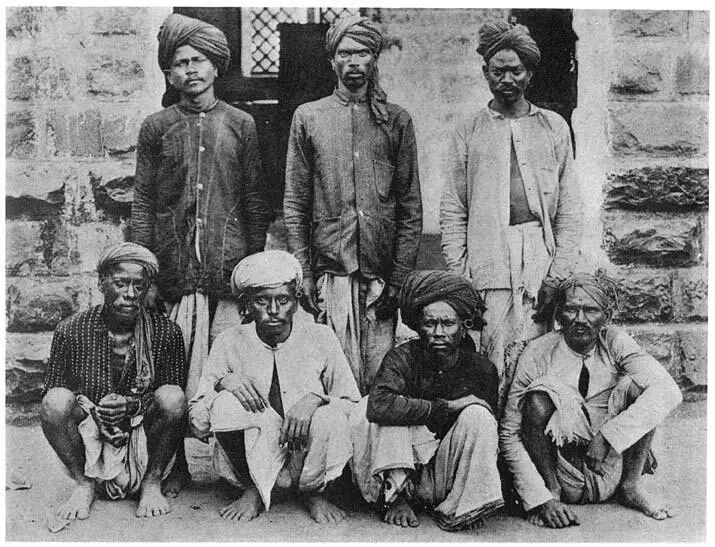Robert Vane Russell - The Tribes and Castes of the Central Provinces of India, Volume 4
Здесь есть возможность читать онлайн «Robert Vane Russell - The Tribes and Castes of the Central Provinces of India, Volume 4» — ознакомительный отрывок электронной книги совершенно бесплатно, а после прочтения отрывка купить полную версию. В некоторых случаях можно слушать аудио, скачать через торрент в формате fb2 и присутствует краткое содержание. Жанр: foreign_prose, История, foreign_edu, foreign_antique, на английском языке. Описание произведения, (предисловие) а так же отзывы посетителей доступны на портале библиотеки ЛибКат.
- Название:The Tribes and Castes of the Central Provinces of India, Volume 4
- Автор:
- Жанр:
- Год:неизвестен
- ISBN:нет данных
- Рейтинг книги:4 / 5. Голосов: 1
-
Избранное:Добавить в избранное
- Отзывы:
-
Ваша оценка:
- 80
- 1
- 2
- 3
- 4
- 5
The Tribes and Castes of the Central Provinces of India, Volume 4: краткое содержание, описание и аннотация
Предлагаем к чтению аннотацию, описание, краткое содержание или предисловие (зависит от того, что написал сам автор книги «The Tribes and Castes of the Central Provinces of India, Volume 4»). Если вы не нашли необходимую информацию о книге — напишите в комментариях, мы постараемся отыскать её.
The Tribes and Castes of the Central Provinces of India, Volume 4 — читать онлайн ознакомительный отрывок
Ниже представлен текст книги, разбитый по страницам. Система сохранения места последней прочитанной страницы, позволяет с удобством читать онлайн бесплатно книгу «The Tribes and Castes of the Central Provinces of India, Volume 4», без необходимости каждый раз заново искать на чём Вы остановились. Поставьте закладку, и сможете в любой момент перейти на страницу, на которой закончили чтение.
Интервал:
Закладка:
11. The goddess Devi
Devi signifies ‘ the goddess’ par excellence . She is often the tutelary goddess of the village and of the family, and is held to have been originally Mother Earth, which may be supposed to be correct. In tracts where the people of northern and southern India meet she is identified with Anna Pūrna, the corn-goddess of the Telugu country; and in her form of Gauri or ‘the Yellow One’ she is perhaps herself the yellow corn. As Gauri she is worshipped at weddings in conjunction with Ganesh or Ganpati, the god of Good Fortune; and it is probably in honour of the harvest colour that Hindus of the upper castes wear yellow at their weddings and consider it lucky. A Brahman also prefers to wear yellow when eating his food. It has been seen 12 12 Vide article on Lakhera.
that red is the lucky colour of the lower castes of Hindus, and the reason probably is that the shrines of their gods are stained red with the blood of the animals sacrificed. High-caste Hindus no longer make animal sacrifices, and their offerings to Siva, Vishnu and Devi consist of food, flowers and blades of corn. Thus yellow would be similarly associated with the shrines of the gods. All Hindu brides have their bodies rubbed with yellow turmeric, and the principal religious flower, the marigold, is orange-yellow. Yellow is, however, also lucky as being the colour of Vishnu or the Sun, and a yellow flag is waved above his great temple at Rāmtek on the occasion of the fair. Thus Devi as the corn-goddess perhaps corresponds to Demeter, but she is not in this form an animal goddess. The Hindus worshipping Mother Earth, as all races do in the early stage of religion, may by a natural and proper analogy have ascribed the gift of the corn to her from whom it really comes, and have identified her with the corn-goddess. This is by no means a full explanation of the goddess Devi, who has many forms. As Pārvati, the hill-maiden, and Durga, the inaccessible one, she is the consort of Siva in his character of the mountain-god of the Himalayas; as Kāli, the devourer of human flesh, she is perhaps the deified tiger; and she may have assimilated yet more objects of worship into her wide divinity. But there seems no special reason to hold that she is anywhere believed to be the deified buffalo; and the probable explanation of the Dasahra rite would therefore seem to be that the buffalo was at first venerated as the corn-god because, like the pig in Greece, he was most destructive to the crops, and a buffalo was originally slaughtered and eaten sacramentally as an act of worship. At a later period the divinity attaching to the corn was transferred to Devi, an anthropomorphic deity of a higher class, and in order to explain the customary slaughter of the buffalo, which had to be retained, the story became current that the beneficent goddess fought and slew the buffalo-demon which injured the crops, for the benefit of her worshippers, and the fast was observed and the buffalo sacrificed in commemoration of this event. It is possible that the sacrifice of the buffalo may have been a non-Aryan rite, as the Mundas still offer a buffalo to Deswāli, their forest god, in the sacred grove; and the Korwas of Sargūja nave periodical sacrifices to Kāli in which many buffaloes are slaughtered. In the pictures of her fight with Bhainsāsur, Devi is shown as riding on a tiger, and the uneducated might imagine the struggle to have resembled that between a tiger and a buffalo. As the destroyer of buffaloes and deer which graze on the crops the tiger may even be considered the cultivator’s friend. But in the rural tracts Bhainsāsur himself is still venerated in the guise of a corn-deity, and pig are perhaps offered to him as the animals which nowadays do most harm to the crops.
Kunbi
[This article is based on the information collected for the District Gazetteers of the Central Provinces, manuscript notes furnished by Mr. A.K. Smith, C.S., and from papers by Pandit Pyāre Lāl Misra and Munshi Kanhya Lāl. The Kunbis are treated in the Poona and Khāndesh volumes of the Bombay Gazetteer . The caste has been taken as typical of the Marāthi-speaking Districts, and a fairly full description of the marriage and other ceremonies has therefore been given, some information on houses, dress and food being also reproduced from the Wardha and Yeotmal District Gazetteers .]
1. Distribution of the caste and origin of name
Kunbi—The great agricultural caste of the Marātha country. In the Central Provinces and Berār the Kunbis numbered nearly 1,400,000 persons in 1911; they belong to the Nāgpur, Chānda, Bhandāra, Wardha, Nimār and Betūl Districts of the Central Provinces. In Berār their strength was 800,000, or nearly a third of the total population. Here they form the principal cultivating class over the whole area except in the jungles of the north and south, but muster most strongly in the Buldāna District to the west, where in some tāluks nearly half the population belongs to the Kunbi caste. In the combined Province they are the most numerous caste except the Gonds. The name has various forms in Bombay, being Kunbi or Kulambi in the Deccan, Kulwādi in the south Konkan, Kanbi in Gujarāt, and Kulbi in Belgaum. In Sanskrit inscriptions it is given as Kutumbika (householder), and hence it has been derived from kutumba , a family. A chronicle of the eleventh century quoted by Forbes speaks of the Kutumbiks or cultivators of the grāms, or small villages. 13 13 Rāsmāla , i. p. 100.
Another writer describing the early Rājpūt dynasties says: 14 14 Ibidem , p. 241.
“The villagers were Koutombiks (householders) or husbandmen (Karshuks); the village headmen were Putkeels (patels).” Another suggested derivation is from a Dravidian root kul a husbandman or labourer; while that favoured by the caste and their neighbours is from kun , a root, or kan grain, and bi , seed; but this is too ingenious to be probable.

Group of Kunbis
2. Settlement in the Central Provinces
It is stated that the Kunbis entered Khāndesh from Gujarāt in the eleventh century, being forced to leave Gujarāt by the encroachments of Rājpūt tribes, driven south before the early Muhammadan invaders of northern India. 15 15 Khāndesh Gazetteer , p. 62.
From Khāndesh they probably spread into Berār and the adjoining Nāgpur and Wardha Districts. It seems probable that their first settlement in Nāgpur and Wardha took place not later than the fourteenth century, because during the subsequent period of Gond rule we find the offices of Deshmukh and Deshpāndia in existence in this area. The Deshmukh was the manager or headman of a circle of villages and was responsible for apportioning and collecting the land revenue, while the Deshpāndia was a head patwari or accountant. The Deshmukhs were usually the leading Kunbis, and the titles are still borne by many families in Wardha and Nāgpur. These offices 16 16 Bombay Gazetteer , vol. i. part ii. p. 34.
belong to the Marātha country, and it seems necessary to suppose that their introduction into Wardha and Berār dates from a period at least as early as the fourteenth century, when these territories were included in the dominions of the Bahmani kings of Bījapur. A subsequent large influx of Kunbis into Wardha and Nāgpur took place in the eighteenth century with the conquest of Raghūji Bhonsla and the establishment of the Marātha kingdom of Nāgpur. Traces of these separate immigrations survive in the subdivisions of the caste, which will now be mentioned.
Интервал:
Закладка:
Похожие книги на «The Tribes and Castes of the Central Provinces of India, Volume 4»
Представляем Вашему вниманию похожие книги на «The Tribes and Castes of the Central Provinces of India, Volume 4» списком для выбора. Мы отобрали схожую по названию и смыслу литературу в надежде предоставить читателям больше вариантов отыскать новые, интересные, ещё непрочитанные произведения.
Обсуждение, отзывы о книге «The Tribes and Castes of the Central Provinces of India, Volume 4» и просто собственные мнения читателей. Оставьте ваши комментарии, напишите, что Вы думаете о произведении, его смысле или главных героях. Укажите что конкретно понравилось, а что нет, и почему Вы так считаете.












